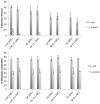Antimicrobial Activity of Selected Phytochemicals against Escherichia coli and Staphylococcus aureus and Their Biofilms
- PMID: 25437810
- PMCID: PMC4243457
- DOI: 10.3390/pathogens3020473
Antimicrobial Activity of Selected Phytochemicals against Escherichia coli and Staphylococcus aureus and Their Biofilms
Abstract
Bacteria can be resistant to multiple antibiotics and we are fast approaching a time when antibiotics will not work on some bacterial infections. New antimicrobial compounds are urgently necessary. Plants are considered the greatest source to obtain new antimicrobials. This study aimed to assess the antimicrobial activity of four phytochemicals-7-hydroxycoumarin (7-HC), indole-3-carbinol (I3C), salicylic acid (SA) and saponin (SP)-against Escherichia coli and Staphylococcus aureus, either as planktonic cells or as biofilms. These bacteria are commonly found in hospital-acquired infections. Some aspects on the phytochemicals mode of action, including surface charge, hydrophobicity, motility and quorum-sensing inhibition (QSI) were investigated. In addition, the phytochemicals were combined with three antibiotics in order to assess any synergistic effect. 7-HC and I3C were the most effective phytochemicals against E. coli and S. aureus. Both phytochemicals affected the motility and quorum-sensing (QS) activity, which means that they can play an important role in the interference of cell-cell interactions and in biofilm formation and control. However, total biofilm removal was not achieved with any of the selected phytochemicals. Dual combinations between tetracycline (TET), erythromycin (ERY) and ciprofloxacin (CIP) and I3C produced synergistic effects against S. aureus resistant strains. The overall results demonstrates the potential of phytochemicals to control the growth of E. coli and S. aureus in both planktonic and biofilm states. In addition, the phytochemicals demonstrated the potential to act synergistically with antibiotics, contributing to the recycling of old antibiotics that were once considered ineffective due to resistance problems.
Figures
Similar articles
-
The use of selected phytochemicals with EDTA against Escherichia coli and Staphylococcus epidermidis single- and dual-species biofilms.Lett Appl Microbiol. 2019 Apr;68(4):313-320. doi: 10.1111/lam.13137. Epub 2019 Mar 13. Lett Appl Microbiol. 2019. PMID: 30790318
-
Combinatorial approaches with selected phytochemicals to increase antibiotic efficacy against Staphylococcus aureus biofilms.Biofouling. 2016 Oct;32(9):1103-14. doi: 10.1080/08927014.2016.1232402. Biofouling. 2016. PMID: 27643487
-
Biofilm formation in erythromycin-resistant Staphylococcus aureus and the relationship with antimicrobial susceptibility and molecular characteristics.Microb Pathog. 2018 Nov;124:47-53. doi: 10.1016/j.micpath.2018.08.021. Epub 2018 Aug 15. Microb Pathog. 2018. PMID: 30118805
-
Bacterial quorum sensing inhibitors: attractive alternatives for control of infectious pathogens showing multiple drug resistance.Recent Pat Antiinfect Drug Discov. 2013 Apr;8(1):68-83. doi: 10.2174/1574891x11308010012. Recent Pat Antiinfect Drug Discov. 2013. PMID: 23394143 Review.
-
Insights on antimicrobial resistance, biofilms and the use of phytochemicals as new antimicrobial agents.Curr Med Chem. 2015;22(21):2590-614. doi: 10.2174/0929867322666150530210522. Curr Med Chem. 2015. PMID: 26028341 Review.
Cited by
-
Chronic wound biofilms: diagnosis and therapeutic strategies.Chin Med J (Engl). 2019 Nov 20;132(22):2737-2744. doi: 10.1097/CM9.0000000000000523. Chin Med J (Engl). 2019. PMID: 31725458 Free PMC article.
-
Quorum Quenching-Guided Inhibition of Mixed Bacterial Biofilms and Virulence Properties by Protein Derived From Leaves of Carissa carandas.Front Cell Infect Microbiol. 2022 Jul 14;12:836819. doi: 10.3389/fcimb.2022.836819. eCollection 2022. Front Cell Infect Microbiol. 2022. PMID: 35909977 Free PMC article.
-
Opening New Roads for Multi-Directional Functional Applications Through In Vitro Chemical and Biological Analysis of Zoegea leptaurea L. Extracts.Food Sci Nutr. 2025 May 13;13(5):e70261. doi: 10.1002/fsn3.70261. eCollection 2025 May. Food Sci Nutr. 2025. PMID: 40365039 Free PMC article.
-
Analysis of antibacterial and antibiofilm activity of purified recombinant Azurin from Pseudomonas aeruginosa.Iran J Microbiol. 2019 Apr;11(2):166-176. Iran J Microbiol. 2019. PMID: 31341572 Free PMC article.
-
Biofilm Formation by Pathogenic Bacteria: Applying a Staphylococcus aureus Model to Appraise Potential Targets for Therapeutic Intervention.Pathogens. 2022 Mar 23;11(4):388. doi: 10.3390/pathogens11040388. Pathogens. 2022. PMID: 35456063 Free PMC article. Review.
References
LinkOut - more resources
Full Text Sources
Other Literature Sources
Molecular Biology Databases


